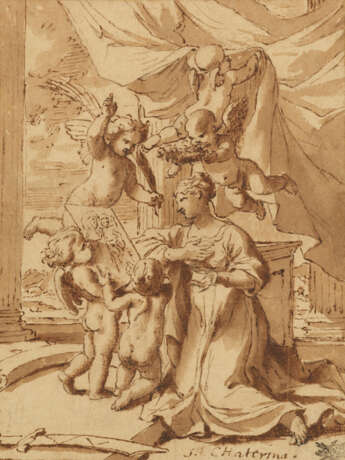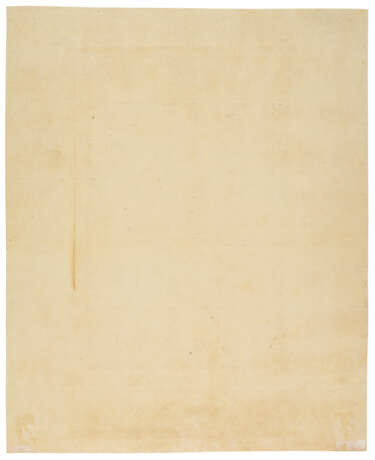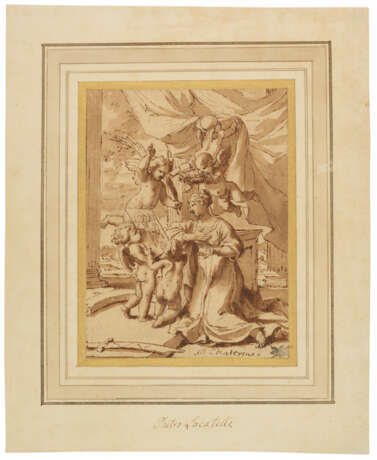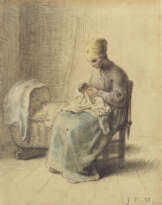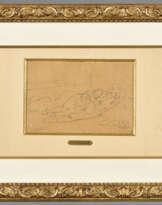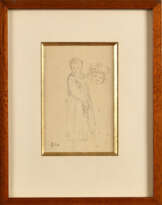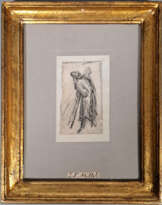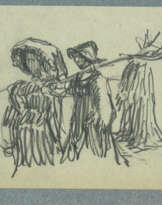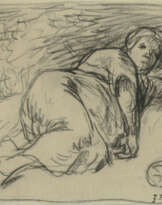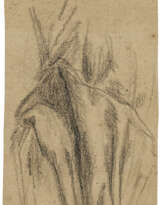ID 1389963
Lot 59 | NICOLAS POUSSIN (LES ANDELYS 1594-1665 ROME)
Valeur estimée
€ 60 000 – 80 000
La Conversion de Sainte Catherine
avec inscription ‘S. CHaterina.’ (en bas à droite)
plume et encre brune, lavis brun
15,9 x 12 cm (6 ¼ x 4 ¾ in.)
Provenance
Jonathan Richardson senior (1667-1745), Londres (Lugt 2183), avec son montage associé inscrit ‘Pietro Locatelli’.
Collection particulière française.
Further details
NICOLAS POUSSIN, THE CONVERSION OF SAINT CATHERINE, PEN AND BROWN INK, BROWN WASH
Previously unknown, this study of Saint Catherine is a rare addition to the corpus of drawings by one of the greatest painters of French classicism, Nicolas Poussin. This brown wash is characteristic of the artist's early works; highly accomplished in composition.
A Roman period drawing
After he arrived in Rome in 1624, at the age of thirty, Poussin frequented the Flemish sculptor François Duquesnoy (1597-1643) and spent time in the studio of Domenichino (1581-1641) where he could practice drawing from life. He quickly began to receive religious commissions, including the large altarpiece of the Martyrdom of Saint Erasmus, for the Basilica of Saint Peter, the earliest of such works by the artist to survive (now in the Pinacoteca Vaticana, Rome, inv. 40394). The present drawing very probably dates from the same decade, around 1627-1630.
In 1994, Pierre Rosenberg and Louis-Antoine Prat identified a group of five drawings of mythological subjects in pen and brown ink, heightened with a very luminous brown wash, which had apparently are not later transformed into paintings. These Mars and Venus and Acis and Galatea are in the Musée Condé in Chantilly (fig. 1; inv. AI 174 NI 208; inv. AI 174bis; NI209; P. Rosenberg, L.-A. Prat, Nicolas Poussin (1594-1665). Catalogue raisonné des dessins, Milan, 1994, I., n° 49, 48, ill), Two Fighting putti and Jupiter and Antiope, at the Beaux-Arts de Paris (inv. 1421 and inv. 2865; op. cit., n° 45, 47, ill) and Theseus abandoning Ariadne in the Uffizi, Florence (in. 5740S; op. cit., n° 46). All show affinities with Saint Catherine.
Certain elements of the compositions can be cited more specifically that give great coherence to the group, such as the hair and facial expressions of the putti, the horizontal hatching in the background, the luminosity that emanates from the compositions due to the judicious use of blank paper, which contrasts with the broader areas of brown wash, and the ‘beauty of the pale wash and the clarity of the definition of the forms’ so perfectly described by Pierre Rosenberg and Louis-Antoine Prat (Nicolas Poussin. La collection du musée Condé à Chantilly, exhibition catalogue, Château de Chantilly, musée Condé, 1994-1995, p. 84). In execution, the present drawing is particularly comparable with the Chantilly Mars and Venus (fig. 1). The overall composition also shares some elements with a painting of the Flight into Egypt in the Sammlung Oskar Reinhart, Winterthur, dated around 1630 by Jacques Thuillier, in which a similar group of putti push back a curtain and holding a wreath of flowers as in the present drawing, in reverse (fig. 2; J. Thuillier, Nicolas Poussin, Paris, 2015, no. 80, ill).
The iconography of Saint Catherine
Although Saint Catherine is most often depicted as a martyr with her wheel, here - and this quite unusual - she is shown being converted to Christianity as a result of a painting. In the drawing, the saint is looking, tenderly at the Christ Child in the hand resting on her heart, at a work depicting the Infant Jesus in the arms of the Virgin. The sacred image is held in front of her by two putti, while two others bring her a martyr's palm and crown of flowers. This apocryphal episode in the life of the saint was recounted by Jacques de Voragine (c.1230-1298) in the 13th Century and retold by the Belgian Carthusian Pierre Dorland (1454-1507) in the second half of the 15th Century: ‘King Costus, on his deathbed, made his daughter Catherine promise to marry only a man equal to her in wisdom and beauty. Catherine's mother, who was secretly a Christian, took her to a hermit who told her of a fiancé who surpassed her in everything and whose kingdom was eternal. At the same time, he presented her with an image of the Infant Jesus in the arms of the Virgin. Catherine knelt before the image of her mystical fiancé' (L. Réau, L'Iconographie de l'art chrétien. III, L'iconographie des saints, I, Paris, 1958, p. 267-268).
A prestigious English provenance
An eminent English collector and portraitist painter, Jonathan Richardson senior (1667-1745) owned nearly 5,000 drawings, most of which were dispersed in a series of sales in January 1747. The collection largely consisted of Italian drawings, under which heading the present drawing was also classified, having been mistakenly given to Pietro Locatelli (1695-1741), as indicated on the characteristic original mounting. It also included a number of French drawings including other works by Nicolas Poussin and Claude Lorrain (1600-1682), and some from the Northern schools - Rembrandt (1606-1669) and Rubens (1577-1640) - (see C. Gibson-Wood, ‘A judiciously disposed collection’ : Jonathan Richardson Senior's cabinet of drawings', in Collecting Prints and Drawings in Europe, c. 1500-1750, Aldershot, 2003, p. 158).
The present drawing has retained Richardson's original mount with its immediately recognisable gold border, an element which became something of a fashion amongst other English collectors of his time. This is further surrounded by double framing lines in pen and brown ink of varying depths and widths. The drawing also bears Richardson's collector's stamp at right: a painter's palette and by brushes. Rosenberg and Prat have identified no fewer than thirteen drawings by Nicolas Poussin which belonged to Jonathan Richardson senior, not counting those that passed for Poussin at the time and are now in the catalogue of rejected works. Conversely, the present sheet is an important addition not only to the body of drawings by Nicolas Poussin but also to the number of authenticated drawings by the artist that belonged to the famous English collector and portrait painter.
| Artiste: | Jean-François Millet (1814 - 1875) |
|---|---|
| Style artistique: | Vieux Maître |
| Lieu d'origine: | Europe de l'Ouest, France, Europe |
| Catégorie maison de vente aux enchères: | Tous les autres types d'objets, Peintures, Aquarelles, Dessins, Dessins, Aquarelles et dessins |
| Artiste: | Jean-François Millet (1814 - 1875) |
|---|---|
| Style artistique: | Vieux Maître |
| Lieu d'origine: | Europe de l'Ouest, France, Europe |
| Catégorie maison de vente aux enchères: | Tous les autres types d'objets, Peintures, Aquarelles, Dessins, Dessins, Aquarelles et dessins |
| Adresse de l'enchère |
CHRISTIE'S 9 Avenue Matignon 75008 Paris France | ||||||||||||||
|---|---|---|---|---|---|---|---|---|---|---|---|---|---|---|---|
| Aperçu |
| ||||||||||||||
| Téléphone | +33 (0)1 40 76 85 85 | ||||||||||||||
| Fax | +33 (0)1 40 76 85 86 | ||||||||||||||
| Conditions d'utilisation | Conditions d'utilisation | ||||||||||||||
| transport |
Service postal Service de messagerie ramassage par vous-même | ||||||||||||||
| Modes de paiement |
Virement bancaire | ||||||||||||||
| Heures d'ouverture | Heures d'ouverture
|
